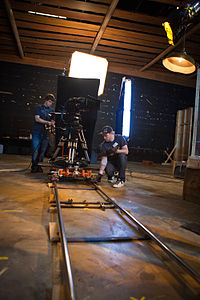
Photo from wikipedia
Structure modeling and optimizing are important topics for the design and control of robots. In this paper, we propose a process for modeling robots and optimizing their structure. This process… Click to show full abstract
Structure modeling and optimizing are important topics for the design and control of robots. In this paper, we propose a process for modeling robots and optimizing their structure. This process is illustrated via a case study of a robot gripper mechanism that has a closed-loop and a single degree of freedom (DOF) structure. Our aim is to conduct a detailed study of the gripper in order to provide an in-depth step-by-step demonstration of the design process and to illustrate the interactions among its steps. First, geometric model is established to find the relationship between the operational coordinates giving the location of the end-effector and the joint coordinates. Then, equivalent Jacobian matrix is derived to find the kinematic model; and the dynamic model is obtained using Lagrange formulation. Based on these models, a structural multi-objective optimization (MOO) problem is formalised in the static configuration of the gripper. The objective is to determine the optimum force extracted by the robot gripper on the surface of a grasped rigid object under geometrical and functional constraints. The optimization problem of the gripper design is solved using a non-dominated sorting genetic algorithm version II (NSGA-II). The Pareto-optimal solutions are investigated to establish some meaningful relationships between the objective functions and variable values. Finally, design sensitivity analysis is carried out to compute the sensitivity of objective functions with respect to design variables. A general robot modeling and optimal design process is proposed.A case study of a robot gripper is carried out in details to illustrate the proposed process.Data flow and interactions between the geometric, kinematic, and dynamic models are emphasized.A multi-objective optimization design of the gripper is realized using NSGA-II algorithm.A local sensitivity analysis of an optimal solution is performed to identify the most critical links of the gripper.
Journal Title: Robotics and Computer-integrated Manufacturing
Year Published: 2017
Link to full text (if available)
Share on Social Media: Sign Up to like & get
recommendations!